Using Mindfulness Techniques to Support Autism Well-Being
Enhancing Autism Support through Mindfulness and ABA Integration

Mindfulness: A Complementary Approach to Autism Care
Mindfulness has emerged as a valuable strategy for improving the well-being of individuals with autism spectrum disorder (ASD) across age groups. Alongside established therapies like Applied Behavior Analysis (ABA), mindfulness fosters emotional regulation, reduces anxiety, and promotes better social communication. This article explores how mindfulness techniques support autism well-being and enhance the impact of traditional interventions.
Understanding Applied Behavior Analysis (ABA) Therapy in Autism Support
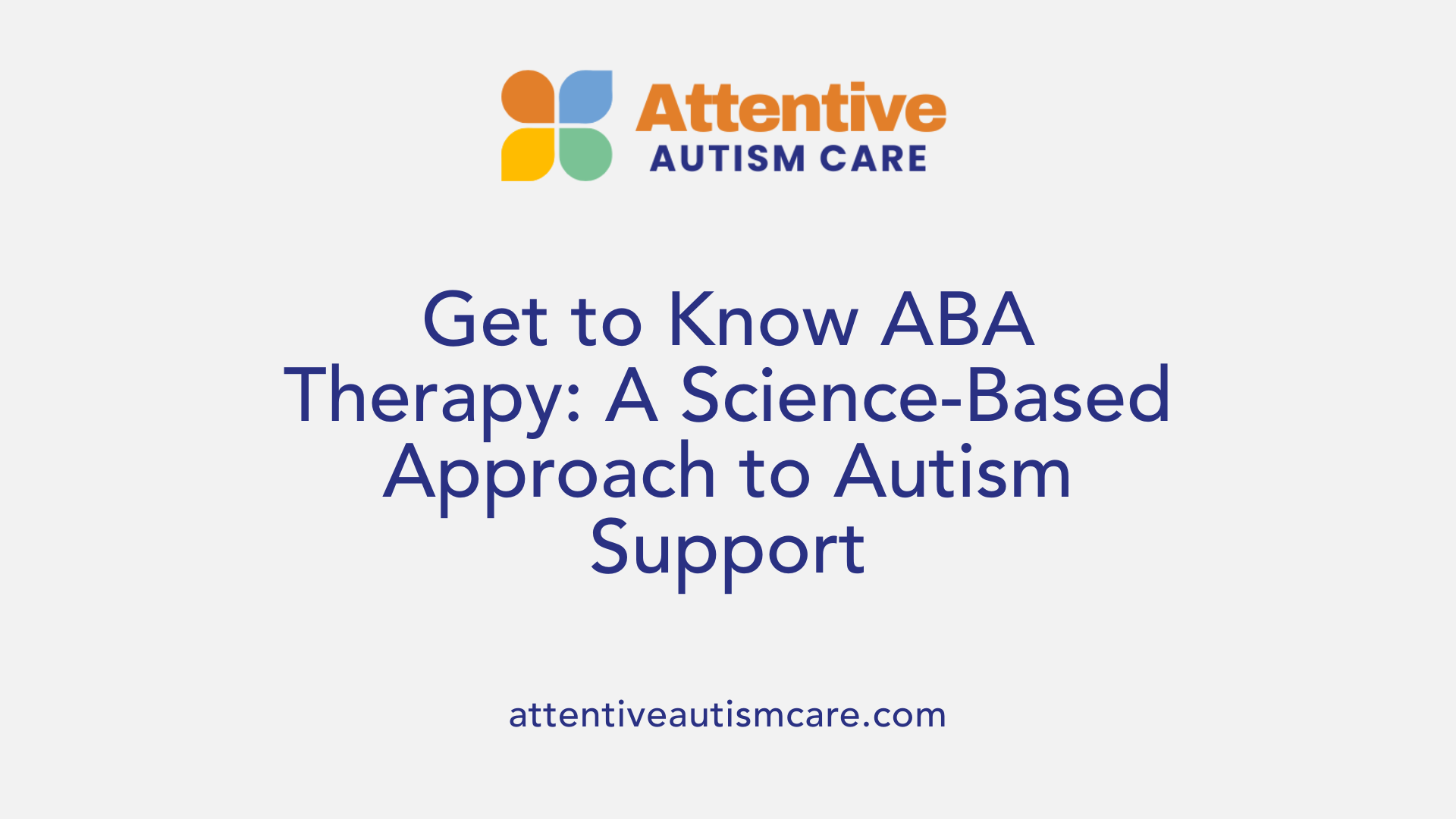
What is Applied Behavior Analysis (ABA) therapy and how is it used to support individuals with autism?
Applied Behavior Analysis (ABA) therapy is a scientifically supported approach that helps individuals with autism build vital skills and reduce challenging behaviors. It is grounded in understanding how behavior is influenced by its antecedents and consequences, allowing therapists to apply positive reinforcement for desirable actions effectively.
ABA therapy is highly personalized and structured, often involving techniques like discrete trial training where tasks are broken down into small, manageable steps. Naturalistic teaching strategies are also employed, enabling skills to be learned in everyday settings.
Role of ABA in autism treatment
ABA plays a central role in autism support by improving communication, social interaction, and independence. It is especially effective when introduced early in a child's development and delivered intensively. ABA strategies can also incorporate behavioral stress management techniques such as relaxation exercises and organized schedules to help individuals cope with anxiety and sensory challenges.
Techniques used in ABA
Key techniques in ABA include visual cues, prompting, and social storytelling, which assist individuals in expressing their needs and reducing frustration. Behavioral interventions may also include training in emotional regulation and managing responses to sensory overload.
Settings for ABA delivery
ABA interventions can be implemented in various environments including clinics, homes, schools, and community settings. Trained professionals, such as Board Certified Behavior Analysts (BCBAs), oversee therapy to ensure goals are tailored to each individual's needs.
Effectiveness and research support for ABA
Research underscores the effectiveness of ABA in enhancing communication skills, social engagement, and behavioral outcomes. Early and intensive ABA therapy can lead to significant improvements, and combining ABA with complementary strategies like mindfulness programs can further support emotional and behavioral functioning in individuals with autism.
Qualifications and Roles of ABA Therapy Providers
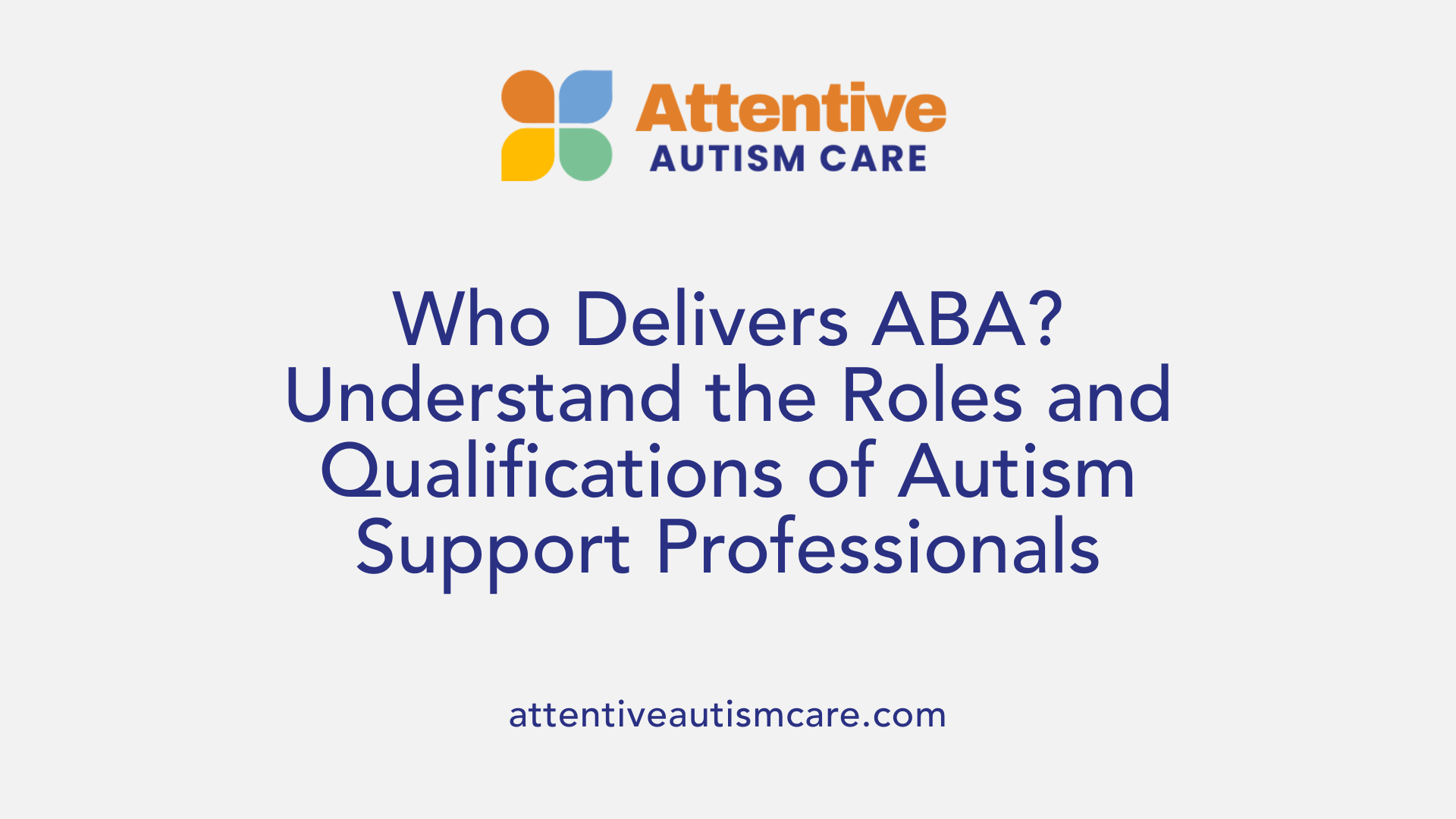
Who typically provides ABA therapy and what qualifications do these professionals have?
ABA therapy is primarily delivered by a range of professionals, each with distinct qualifications and responsibilities. The most highly trained providers are Board Certified Behavior Analysts (BCBAs). BCBAs hold graduate degrees in behavior analysis, psychology, or related fields. They design, supervise, and assess individualized treatment plans tailored specifically for each client’s needs.
What are the qualifications and certifications required?
Alongside BCBAs, there are Board Certified Assistant Behavior Analysts (BCaBAs) and Registered Behavior Technicians (RBTs). BCaBAs act as paraprofessionals with intermediate training who assist BCBAs and implement therapy under their supervision. RBTs, the frontline practitioners providing direct therapy, are required to complete standardized training programs, pass competency assessments, and engage in ongoing supervision to maintain certification.
How is supervision and ethical standards maintained in therapy delivery?
Ethics and supervision form critical pillars in safe and effective ABA therapy. BCBAs oversee both BCaBAs and RBTs, ensuring treatment fidelity and adherence to ethical guidelines outlined by professional bodies. Most practitioners also maintain state licensure, reinforcing regulatory compliance and professionalism.
What are the role distinctions among BCBAs, BCaBAs, RBTs, and therapists?
In this professional hierarchy, BCBAs hold primary responsibility for assessment, treatment planning, and outcome evaluation. BCaBAs support these functions but do not practice independently. RBTs deliver hands-on therapy directed by supervisors. Additionally, behavior therapists may have specialized training and focus on direct intervention techniques, often functioning similarly to RBTs but sometimes with broader or more specialized roles depending on the setting.
This layered structure ensures that ABA therapy is comprehensive, safely delivered, and continuously monitored to meet the evolving needs of individuals with autism and related developmental challenges.
The Integral Role of Parents and Caregivers in ABA Therapy Success

How can parents and caregivers support ABA therapy for their children with autism?
Parents and caregivers play a vital role in the success of ABA therapy. Their active participation begins with attending training sessions and educational programs designed to familiarize them with ABA strategies. This training helps them understand how to apply behavioral techniques at home consistently, reinforcing the skills taught during therapy sessions.
Maintaining open communication with therapists and behavior analysts is essential. By regularly discussing goals, progress, and observations, parents can ensure continuity and consistency across different environments. This collaboration helps tailor the therapy to the child's evolving needs and maximizes outcomes.
Parental involvement also means addressing their own stress and resource challenges. Mindfulness practices have been shown to reduce caregiver stress, enhancing emotional regulation and promoting calmer responses to stressful situations. When caregivers are well-supported, they can respond more effectively and patiently, improving the overall home atmosphere and facilitating the child's progress.
By integrating ABA strategies into daily routines and fostering a supportive environment, parents and caregivers help children generalize their skills beyond therapy sessions. This comprehensive approach ensures greater developmental gains and a smoother transition into varied social settings.
Key Benefits and Considerations of ABA Therapy for Autism
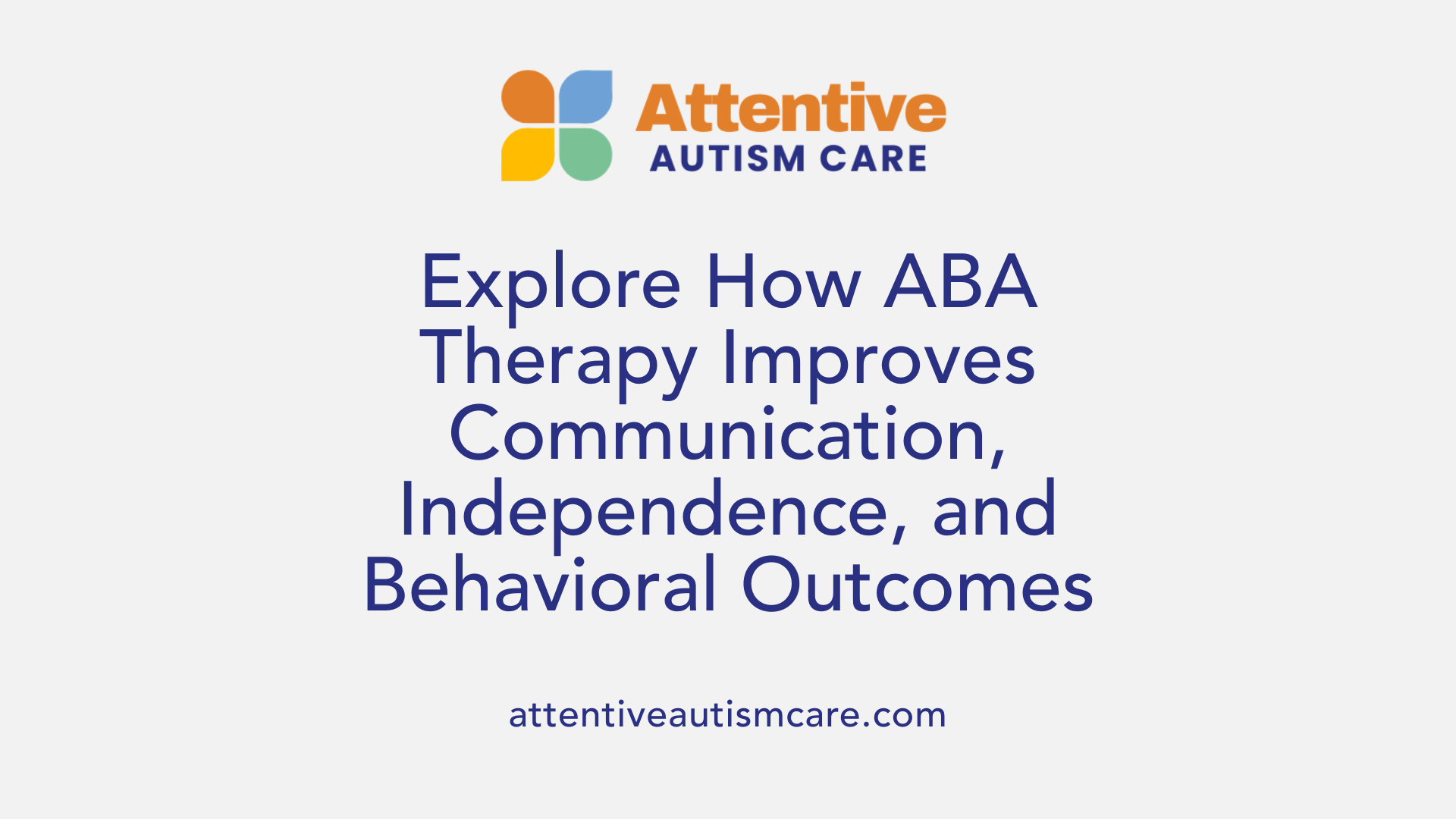
What Are the Key Benefits and Challenges of ABA Therapy for Individuals with Autism?
Applied Behavior Analysis (ABA) therapy is widely recognized for its effectiveness in improving the lives of individuals with autism. It focuses on enhancing communication, social skills, independence, and reducing problematic behaviors. ABA uses structured behavioral strategies such as visual cues, prompting, and social storytelling which help individuals express their needs and reduce frustration.
Outcomes of ABA Therapy
ABA therapy promotes significant improvements, particularly when started early and combined with family involvement. This early, intensive intervention can lead to marked progress in communication and socialization skills. Additionally, ABA integrates stress management techniques like relaxation exercises and organized schedules to support emotional regulation.
Improved Communication and Social Skills
ABA uses tailored approaches to address communication challenges by teaching individuals how to express themselves effectively. It also enhances social interaction capabilities, making it easier for individuals to navigate complex social environments.
Emotional Regulation and Behavior Management
Through consistent behavioral techniques, ABA therapy helps control challenging behaviors and supports emotional regulation. This is crucial for helping individuals manage stress triggered by disruptions in routine or sensory overload.
Challenges Such as Therapy Intensity and Consistency
One major challenge of ABA therapy is its demanding nature. It requires intensive, consistent application to achieve the best outcomes. Maintaining motivation and engagement during therapy sessions can be difficult for both individuals and caregivers.
Ensuring Respectful and Individualized Interventions
Respect for the individual's dignity and personalization of interventions are critical to the success of ABA therapy. Each plan must be tailored to the unique needs and preferences of the individual to maximize benefit and encourage participation.
Despite these challenges, ABA therapy remains a cornerstone of autism treatment strategies, helping many individuals reach their full potential and improving overall quality of life.
Mindfulness as a Strategy to Reduce Anxiety and Stress in Autism
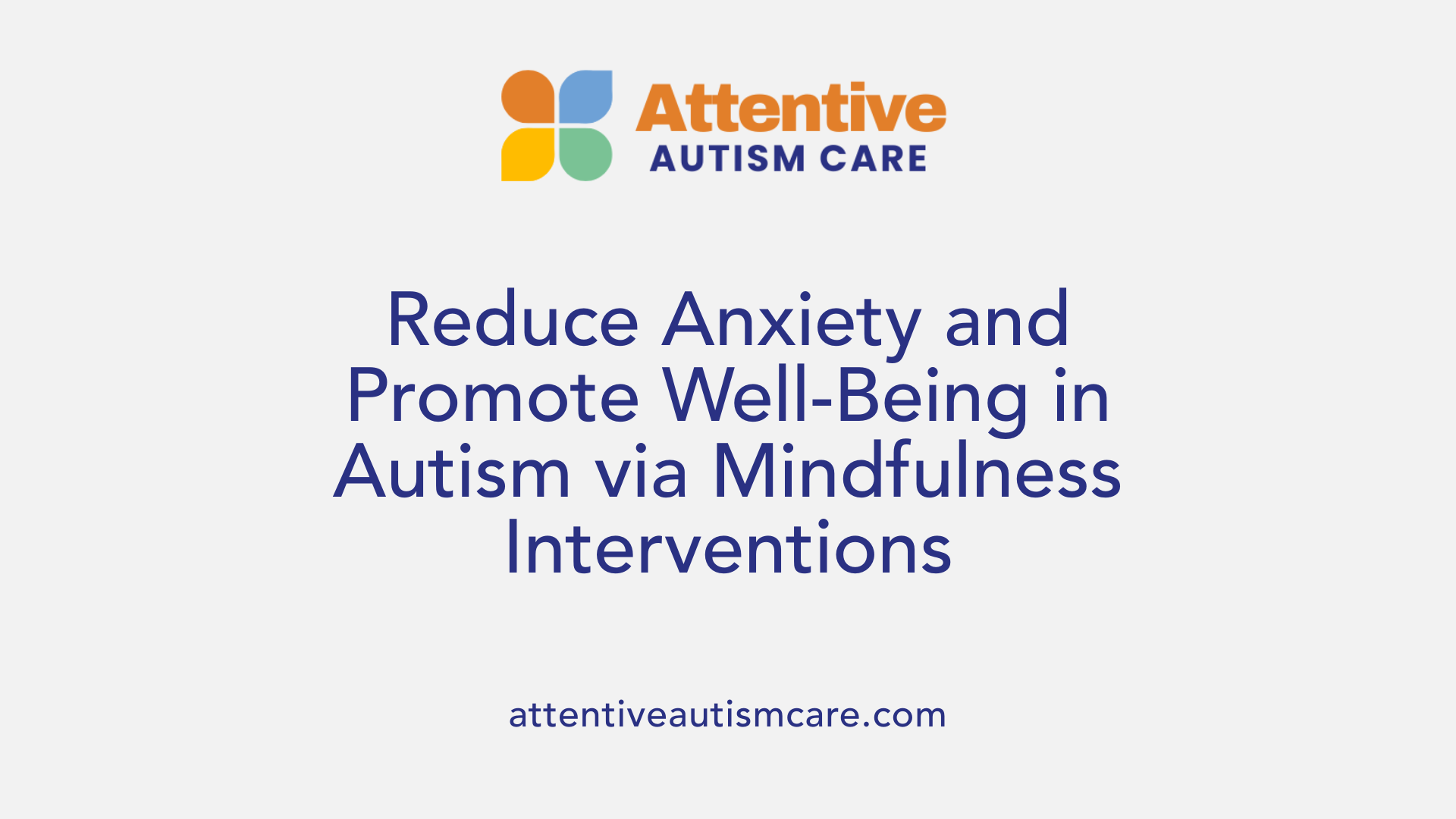
How Effective Is Mindfulness in Reducing Stress and Anxiety for Those with Autism?
Mindfulness is a proven strategy that effectively reduces stress and anxiety in individuals with autism, including children, teenagers, and adults. Research consistently shows that practicing mindfulness enhances serenity by helping individuals stay connected to the present moment. This connection not only alleviates anxiety but also clears mental clutter, making everyday interactions less overwhelming.
What Are the Benefits of Mindfulness Across Age Groups?
For children and teens, mindfulness can improve social communication and emotional regulation, leading to fewer problematic behaviors. Adults with autism also experience reduced anxiety and heightened mental clarity through mindfulness. Additionally, parents practicing mindfulness tend to respond more calmly to stressful situations, which benefits family dynamics and creates a healthier home environment.
Through What Mechanisms Does Mindfulness Provide These Benefits?
Mindfulness promotes awareness of emotions, thoughts, and bodily sensations, which fosters self-regulation. This increased awareness supports individuals in managing their emotional challenges more effectively. It also improves communication and interaction skills, which are crucial for reducing anxiety related to social situations and sensory overload.
What Does Research Say About Mindfulness and Autism?
Studies, including those published by the National Library of Medicine, confirm that mindfulness-based interventions can improve anxiety, social skills, and aggressive behavior in young people with autism. Evidence suggests that mindfulness can lead to sustained improvements in emotional regulation, tolerance of uncertainty, and reduced behavioral issues. Programs delivered in schools, clinics, or homes have shown consistent benefits regardless of whether the instructor is a clinician, parent, or educator.
Improving Social Communication Through Mindfulness Practices
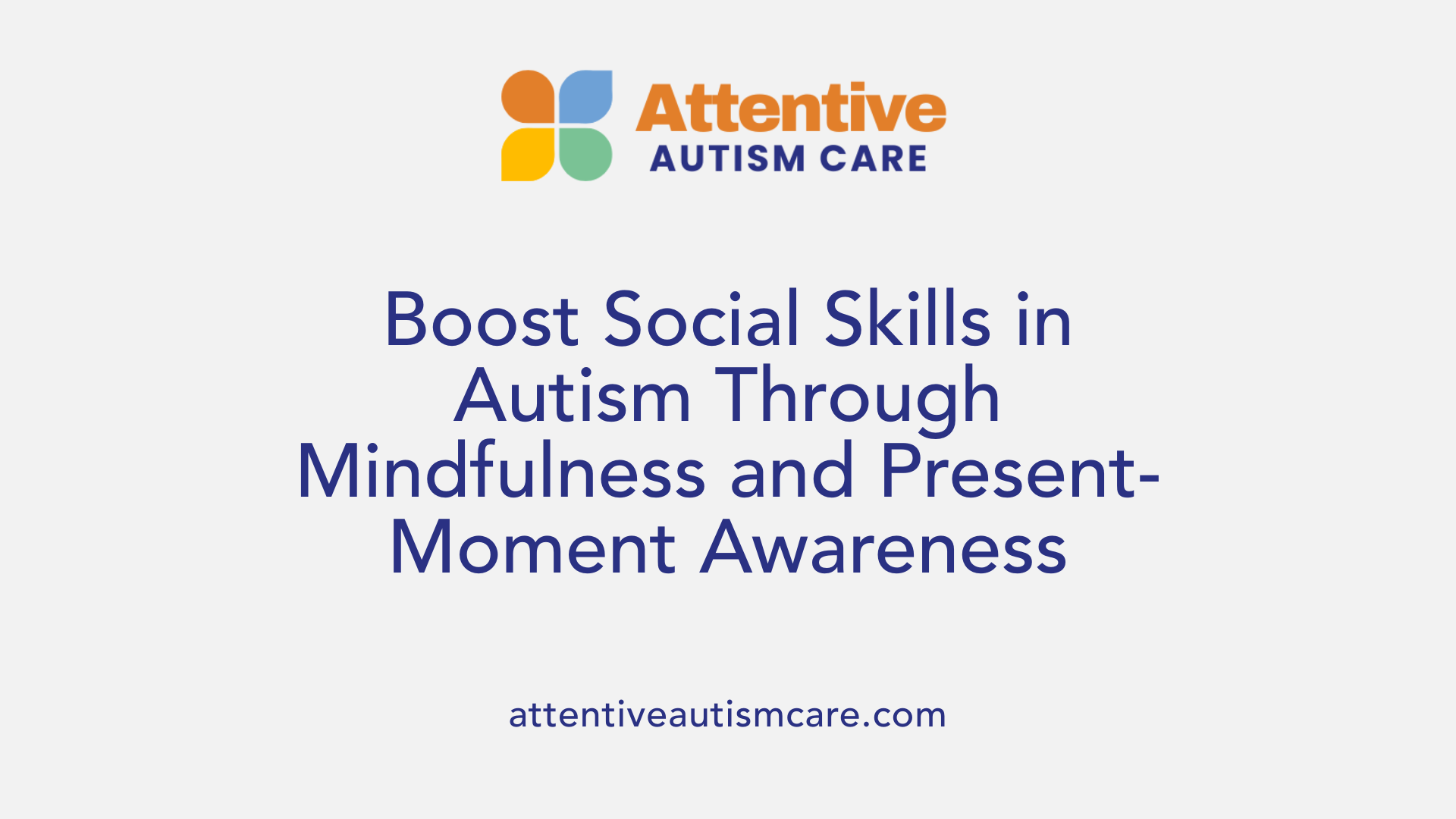
What research evidence supports the impact of mindfulness on social skills in autism?
Research consistently demonstrates that mindfulness interventions enhance social communication abilities in children with autism. A study published by the National Library of Medicine highlights that children participating in mindfulness programs showed measurable improvements in their social interaction skills. This evidence underscores mindfulness as an effective tool for fostering meaningful social engagement among individuals on the autism spectrum.
How does mindfulness improve interaction and communication in individuals with autism?
Mindfulness enhances social communication by cultivating present-moment awareness, which helps individuals recognize and respond more effectively to social cues. Practicing mindfulness increases focus and concentration, allowing children and adults to stay engaged in conversations and interactions longer. Additionally, it reduces anxiety and social stress, which often hinder communication, enabling smoother and more confident exchanges.
What is the connection between mindfulness and social engagement for people with autism?
The practice of mindfulness builds emotional regulation and self-awareness, vital components for successful social participation. By increasing awareness of their emotions and bodily sensations, individuals with autism can manage challenging social situations more effectively. This improved self-regulation reduces social anxiety, making it easier to initiate and maintain relationships. Consequently, mindfulness fosters a supportive foundation for stronger and more positive social connections.
Mindfulness to Enhance Emotional and Behavioral Functioning
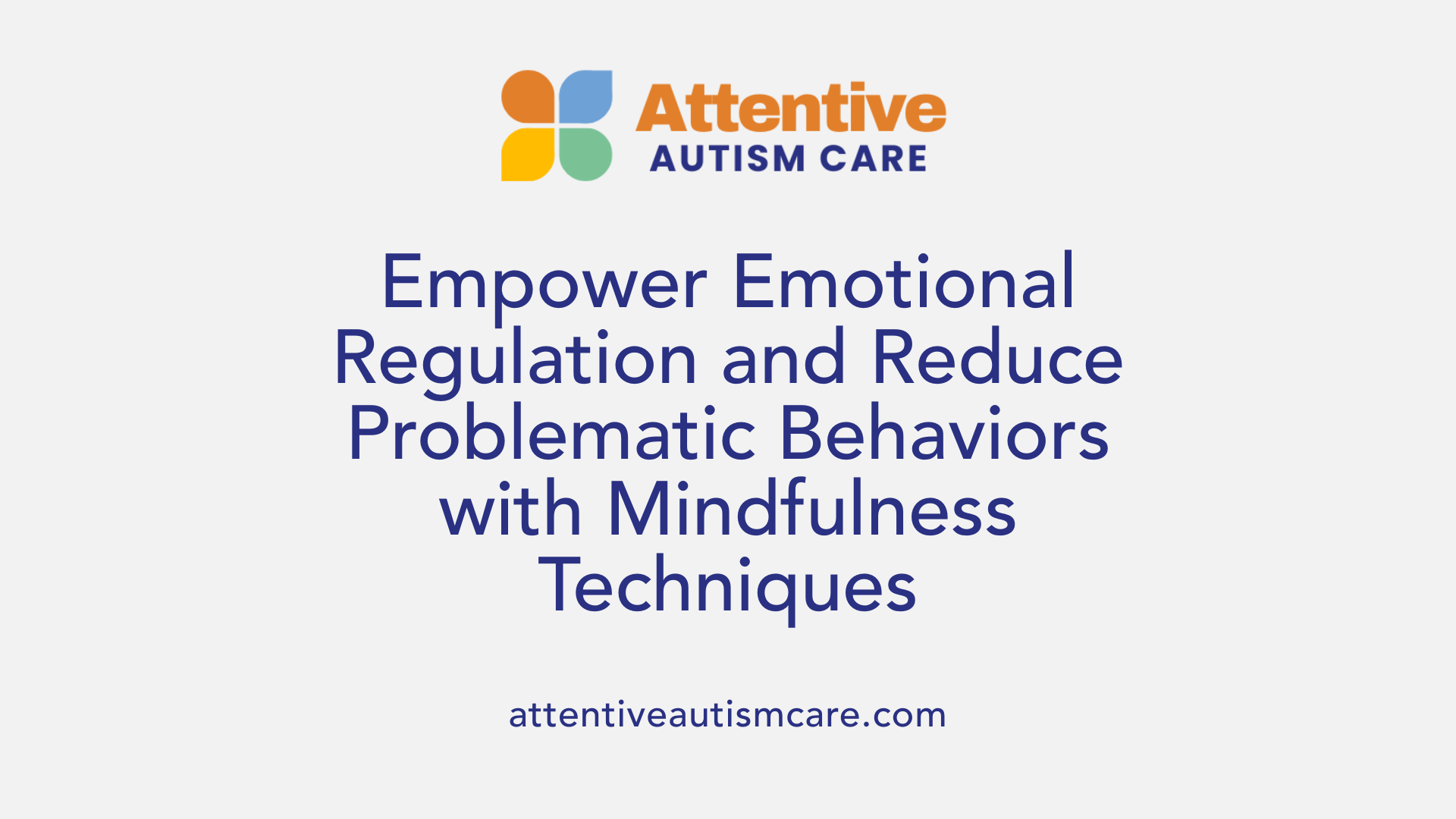
How Do Parents Report Mindfulness Influences Behavior in Autism?
Parents frequently observe positive changes in their children's behavior after engaging in mindfulness programs. These benefits often include reduced instances of problematic behaviors, suggesting mindfulness as a promising tool for behavior management in autism. Such parental reports highlight mindfulness as an accessible strategy that helps children better handle emotional challenges and daily stressors.
What Improvements in Emotional Regulation Are Seen With Mindfulness?
Mindfulness practices nurture greater awareness of emotions, thoughts, and bodily sensations. For individuals with autism, this increased self-awareness supports improved emotional regulation, enabling better management of feelings such as anxiety and frustration. Effective emotional regulation is fundamental for social communication and participation in daily activities.
How Does Mindfulness Reduce Problematic Behaviors?
Mindfulness programs designed for autism often incorporate techniques like deep breathing, body scans, and sensory exploration. These activities foster self-regulation and serenity, which in turn reduce problematic behaviors. By equipping individuals with strategies to manage sensory overload and emotional responses, mindfulness helps create a calmer behavioral state and reduces challenging behaviors over time.
| Aspect | Description | Impact on Autism Behavioral Function |
|---|---|---|
| Parental Reports | Observe decreased problematic behaviors post mindfulness training | Supports use of mindfulness as a behavior management tool |
| Emotional Regulation | Increase in awareness of emotions and bodily states | Enhances self-control and reduces emotional outbursts |
| Mindfulness Techniques | Includes breathing, body scans, and sensory-based activities | Aids in managing sensory overload and impulsivity |
These findings reinforce mindfulness as a valuable intervention promoting emotional and behavioral well-being in individuals with autism.
Strengthening Caregiver Relationships Through Mindfulness
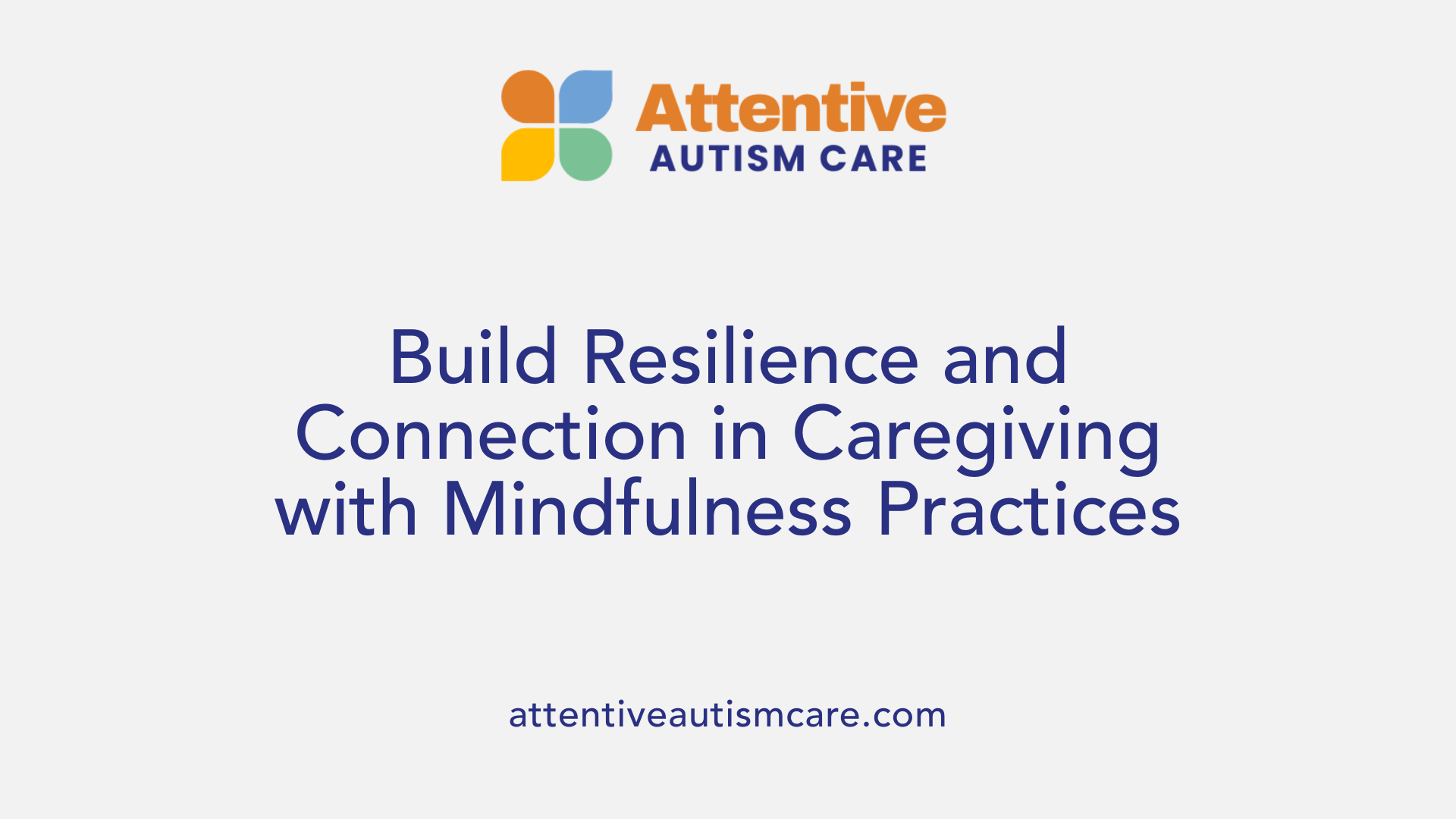
How Does Mindfulness Improve Emotional Management in Caregivers?
Mindfulness helps caregivers of individuals with autism enhance their emotional management skills. By practicing mindfulness techniques such as deep breathing and body scans, caregivers learn to stay calm during stressful situations. This increased emotional awareness allows them to respond thoughtfully rather than react impulsively, reducing feelings of frustration and anxiety.
In What Ways Does Mindfulness Enhance Communication Between Caregivers and Individuals with Autism?
Improved emotional regulation from mindfulness translates into better communication. Caregivers become more attuned to their own feelings and more patient when interacting with autistic individuals. This fosters clearer, more compassionate exchanges, helping both parties connect effectively and allowing for more successful support and guidance.
How Does Mindfulness Impact Overall Family Dynamics?
With reduced parental stress and more manageable emotional responses, mindfulness creates a healthier home environment. Parents report that mindfulness leads to calmer interactions and less conflict, improving relationships not only between caregivers and individuals with autism but throughout the family. The increased serenity and focus fostered by mindfulness contribute to a more supportive and nurturing family atmosphere.
Mindfulness Practices to Support Parenting and Reduce Parental Stress
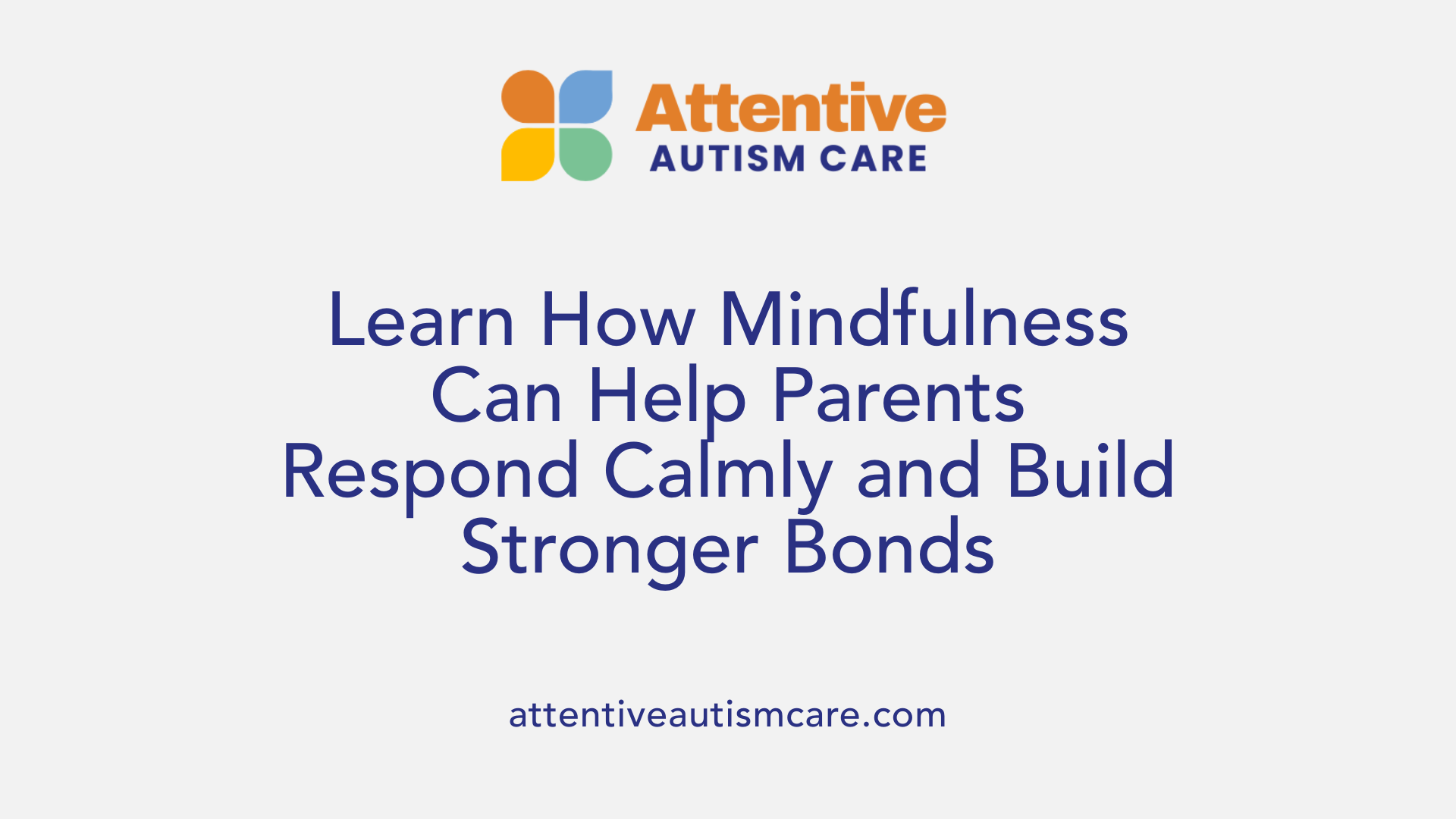
How Does Mindfulness Help Parents Respond More Calmly to Stress?
Mindfulness encourages parents of children with autism to become more aware of their own emotions and reactions. By practicing techniques such as deep breathing and guided visualization, parents can slow down their response to stressful situations. This heightened emotional awareness helps them stay calm and patient during challenging moments, reducing immediate stress reactions.
What Positive Impacts Does Mindfulness Have on Parenting Approaches?
By fostering emotional regulation and present-moment focus, mindfulness improves communication between parents and their autistic children. Parents report greater patience and understanding, enabling more effective and positive interactions. The ability to remain centered helps parents manage problematic behaviors constructively rather than reacting impulsively.
How Does Mindfulness Reduce Parental Stress and Promote a Healthier Home Environment?
Regular mindfulness practice lowers overall parental stress levels, which contributes to creating a more peaceful and supportive atmosphere at home. When parents manage their stress better, it reduces tensions that can affect the entire family dynamic. This calmer environment benefits both caregivers and children by encouraging emotional stability and increasing opportunities for positive engagement.
Mindfulness Techniques to Improve Focus and Self-Regulation in Autism
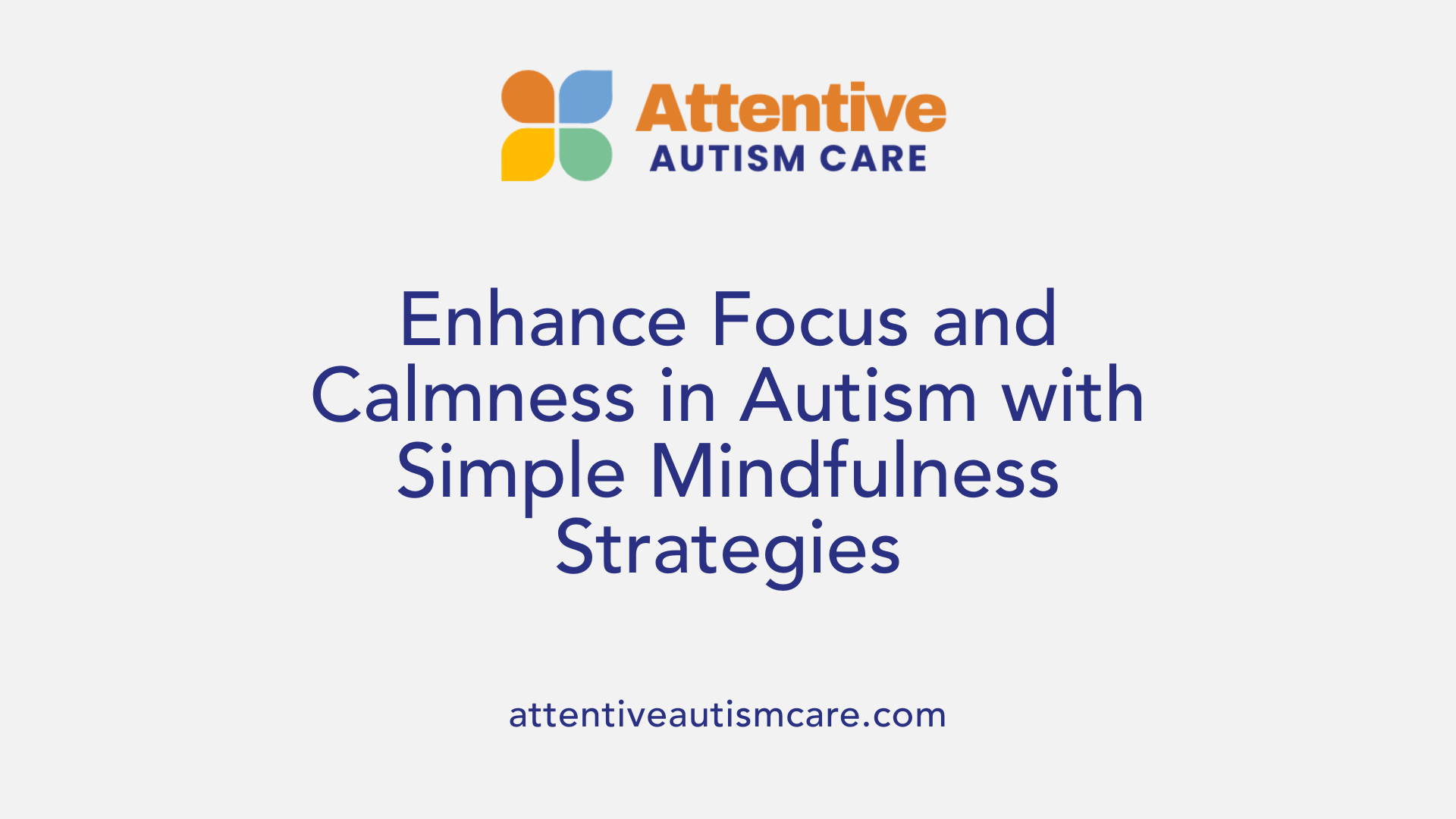
How Does Mindfulness Benefit Concentration and Attention in Individuals with Autism?
Mindfulness practice has been found to significantly enhance focus and concentration for those on the autism spectrum. By encouraging present-moment awareness, individuals learn to direct attention intentionally, which helps sustain engagement with tasks and activities. Improvements in attention facilitate better learning outcomes and participation in daily routines.
In What Ways Does Mindfulness Enhance Awareness of Emotions, Thoughts, and Bodily Sensations?
A core mindfulness skill involves becoming more aware of internal experiences—including emotions, thoughts, and bodily sensations—without judgment. This heightened awareness fosters self-regulation by allowing individuals with autism to recognize early signs of stress or emotional distress. Developing this conscious connection helps manage reactions and reduces overwhelm.
How Does Mindfulness Support Managing Emotional Challenges and Impulse Control?
Mindfulness helps build greater control over emotional responses and impulses by promoting calmness and thoughtful action instead of automatic reactions. Through practices such as deep breathing, body scans, and sensory exploration, individuals gain tools to regulate mood swings and reduce anxiety-driven behaviors. School-based mindfulness programs specifically show promise in helping children regulate impulses and make more deliberate decisions.
Common Mindfulness Strategies Adapted for Autism Include:
- Deep breathing exercises
- Sensory exploration
- Movement activities
- Guided visualization
- Mindful eating
- Body scans
- Listening exercises
- Storytelling
These strategies enhance concentration and self-regulation by addressing sensory sensitivities and improving emotional understanding.
Overall, mindfulness creates a foundation for individuals with autism to increase their attention capacity and effectively manage emotional challenges through present-focused awareness and self-calming techniques.
School-Based Mindfulness Programs and Their Effects
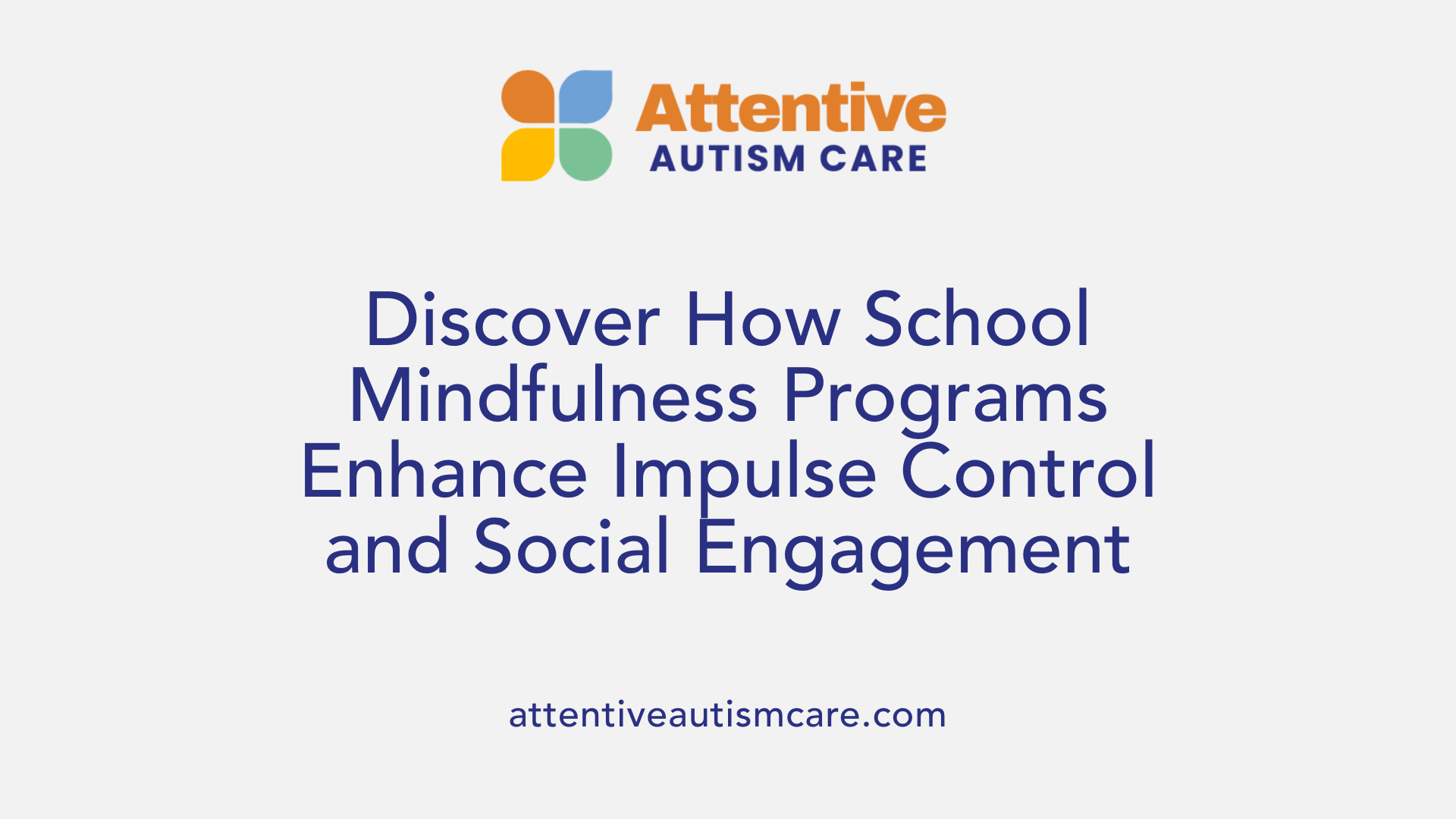
How do school-based mindfulness programs help children with autism control impulses and reduce anxiety?
School-based mindfulness programs play a vital role in aiding children with autism to better manage impulse control and anxiety. These programs use adapted mindfulness strategies such as deep breathing exercises, body scans, and guided visualization to help students become more aware of their emotions and bodily sensations. This awareness empowers children to pause and regulate their responses, leading to improved impulse control. Additionally, mindfulness reduces anxiety by teaching children calming techniques they can implement during stressful moments in the school environment.
In what ways do these programs improve decision-making skills?
By promoting sustained attention and emotional regulation, mindfulness helps children with autism improve decision-making skills. Enhanced concentration allows them to process information more clearly and thoughtfully before acting. Mindfulness fosters self-regulation, thereby encouraging children to think through choices carefully rather than react impulsively. This mindful approach to decision-making contributes to better social interactions and classroom behavior.
How do mindfulness practices assist in managing sensory overload and social anxiety?
Mindfulness strategies also aid children with autism in coping with sensory overload, a common challenge in school settings. Techniques like sensory exploration and mindful breathing help learners monitor and adjust their reactions to overwhelming stimuli. Furthermore, mindfulness supports social anxiety reduction by increasing comfort in social scenarios through improved emotional awareness and communication skills. These benefits collectively create a more supportive and manageable learning environment.
In sum, school-based mindfulness programs adapted for autism provide practical tools that enhance impulse control, reduce anxiety, promote better decision-making, and assist with sensory and social challenges in children.
Mindfulness Strategies Adapted for Autism Spectrum Disorder
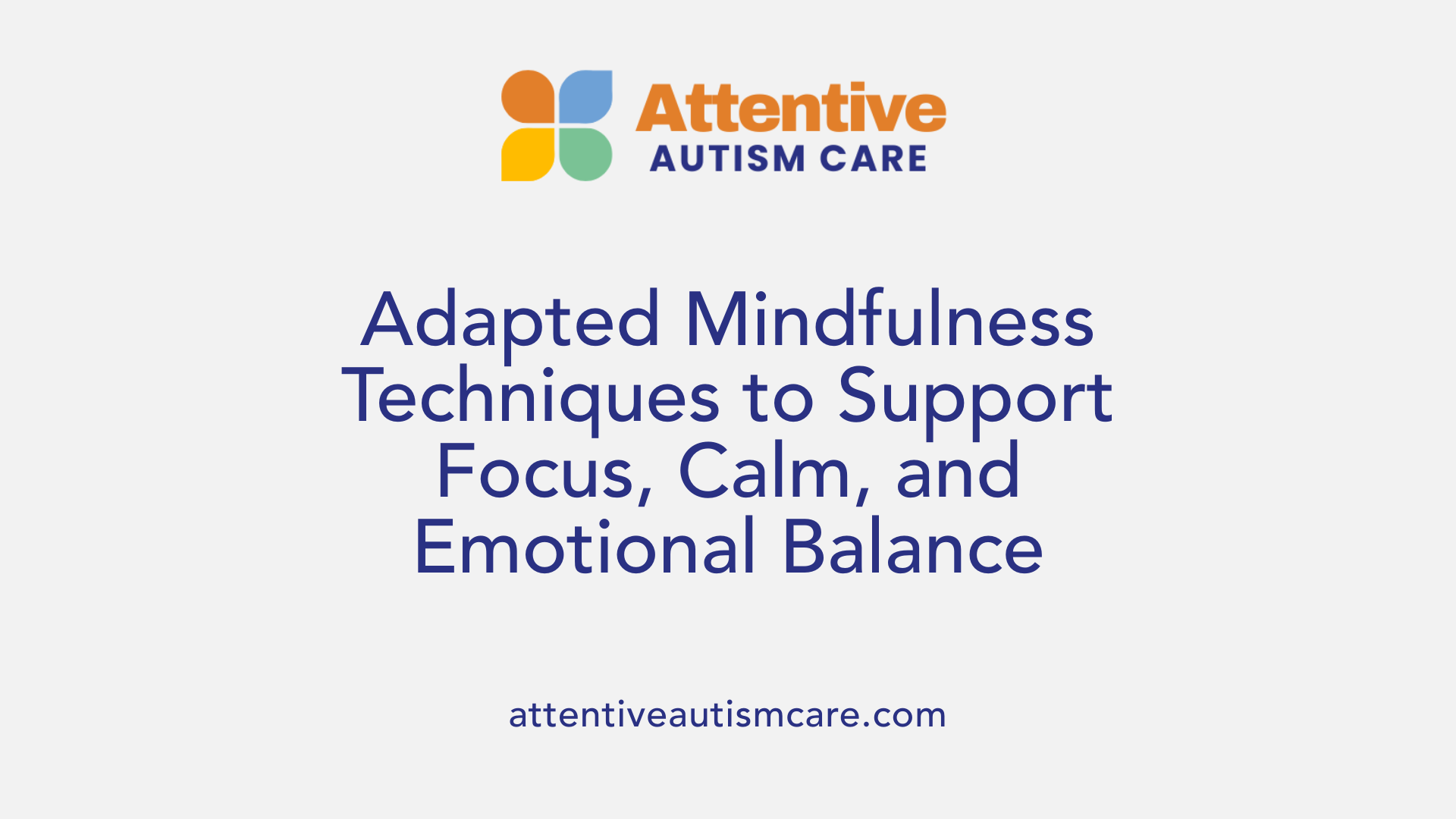
What are examples of specific mindfulness techniques used for individuals with autism?
Mindfulness techniques adapted for autism often include deep breathing exercises, sensory exploration, movement activities, guided visualization, coloring, mindful eating, body scans, listening exercises, walking, and storytelling. These methods offer versatile ways to stay present and calm, catering to various preferences and needs.
How are mindfulness techniques adapted for sensory needs and engagement?
Adaptations consider the unique sensory sensitivities common in autism. For example, sensory exploration activities might focus on gentle tactile experiences or soft sounds that soothe rather than overstimulate. Visual aids like coloring and guided storytelling provide structured engagement that helps maintain focus without overwhelming the individual.
What techniques such as deep breathing, sensory exploration, movement, and guided visualization are beneficial?
Deep breathing exercises allow individuals to regulate stress responses by focusing on breath control, reducing anxiety and improving emotional self-regulation. Movement activities, including yoga or simple stretches, can release tension and increase body awareness. Guided visualization helps create mental safe spaces, enhancing relaxation and reducing sensory overload.
These techniques can be practiced in diverse settings—home, school, or clinic—and often involve parents, educators, or therapists. The adaptability makes mindfulness accessible and effective for children, teenagers, and adults on the spectrum, supporting improved attention, reduced anxiety, and better emotional management.
Integrating Mindfulness into ABA Therapy Programs
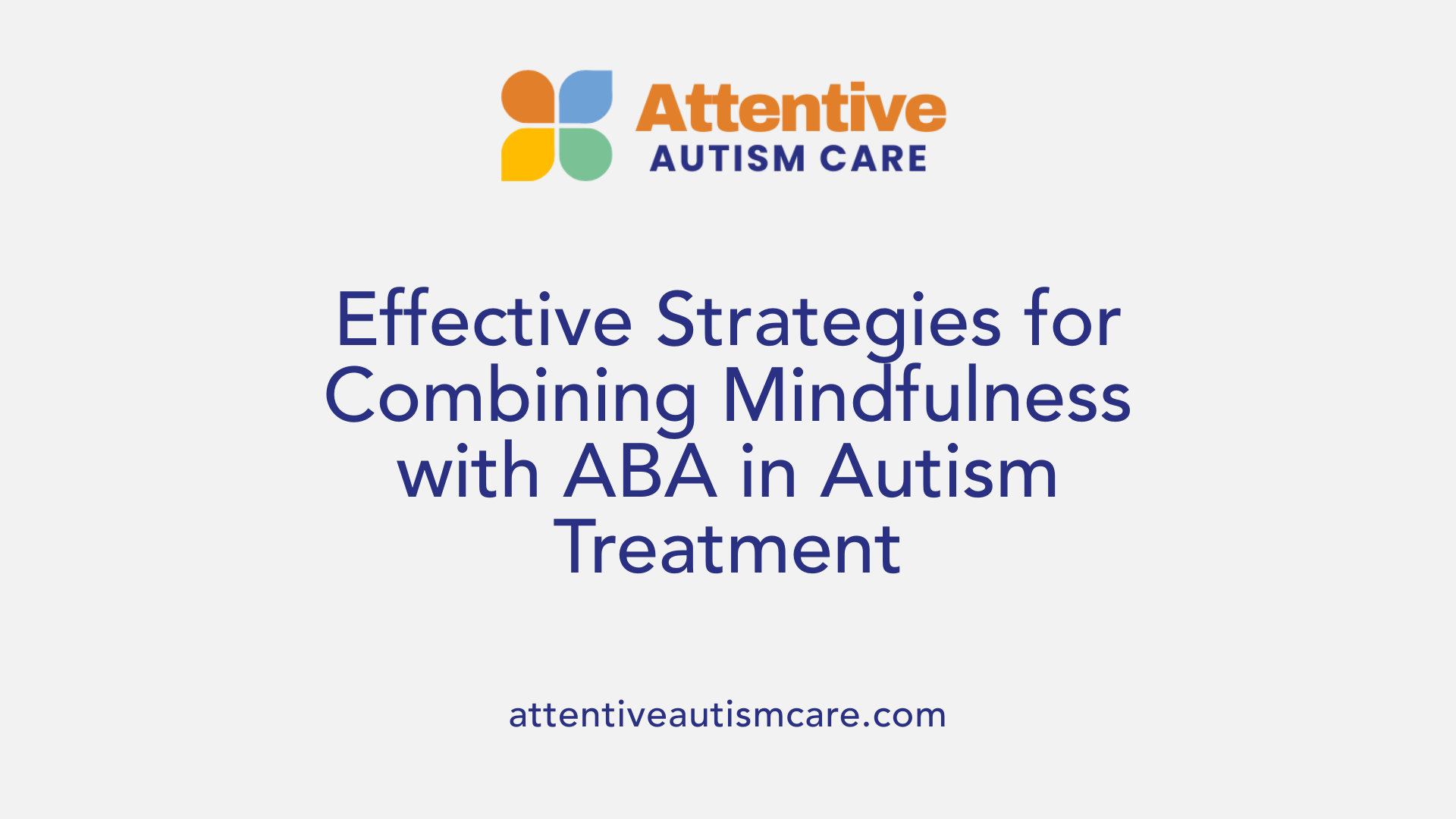
How Is Mindfulness Incorporated in ABA Therapy Centers?
ABA Centers of Florida exemplify the integration of mindfulness techniques within their autism treatment and early intervention programs. These centers blend classic Applied Behavior Analysis (ABA) methods with mindfulness strategies such as deep breathing exercises, guided visualization, and body scans. This combination helps children with autism become more aware of their emotions and bodily sensations while supporting improved behavior and communication.
What Personalized Approaches Blend Mindfulness and Behavioral Analysis?
Personalized treatment plans at ABA centers tailor mindfulness practices alongside ABA to meet each child's unique needs. For example, therapists may incorporate sensory exploration or movement activities to complement behavioral interventions. These approaches enhance emotional regulation and reduce stress responses, creating a calmer, more receptive learning environment. The individualized focus ensures that mindfulness techniques directly support ABA goals like improving social skills and reducing problematic behaviors.
What Are the Benefits of Early Intervention Using Mindfulness in ABA?
Introducing mindfulness in early intervention stages provides foundational benefits for children on the spectrum. Early practice enhances focus, self-regulation, and anxiety management, all key areas targeted by ABA. Mindfulness also aids children in handling sensory overload and social anxiety, making behavioral therapies more effective. By fostering presence and calm in young learners, these integrated programs improve the odds of long-term positive outcomes in communication and behavior.
Mindfulness Training Benefits for Professional Caregivers

How Does Mindfulness Reduce Psychological Stress and Burnout Among Caregivers?
Mindfulness-based training has been shown to significantly lower levels of psychological stress, burnout, and symptoms of depression in professional caregivers supporting individuals with intellectual disabilities and Autism Spectrum Disorder (ASD). These programs encourage caregivers to become more aware of their own emotional states and reactions, helping them maintain calmness and clarity in challenging situations.
In What Ways Does Mindfulness Help Decrease Secondary Traumatic Stress and Depression?
Secondary traumatic stress, a common challenge faced by caregivers due to repeated exposure to others' trauma, is effectively reduced through mindfulness practices. By fostering emotional regulation and self-awareness, mindfulness enables caregivers to manage stress responses better and alleviate depressive symptoms that might arise from prolonged caregiving responsibilities.
What Client Care Improvements Are Linked to Caregivers' Mindfulness Training?
Mindfulness-trained caregivers contribute to better outcomes for their clients. These improvements include fewer behavioral episodes, decreased aggression, enhanced mastery of learning objectives, and reduced need for high levels of supervision. Additionally, caregiver mindfulness correlates with fewer instances of progressive discipline, reduced absenteeism, and lower turnover rates. These factors collectively enhance the quality of care and create a more supportive environment for individuals with autism.
Research highlights that mindfulness-based interventions not only improve caregiver well-being but also positively impact client behavior and overall care system quality assurance. This dual benefit underscores the importance of integrating mindfulness into professional caregiver training programs in autism support services.
Impact of Mindfulness on Caregiver and Client Outcomes in Autism Care
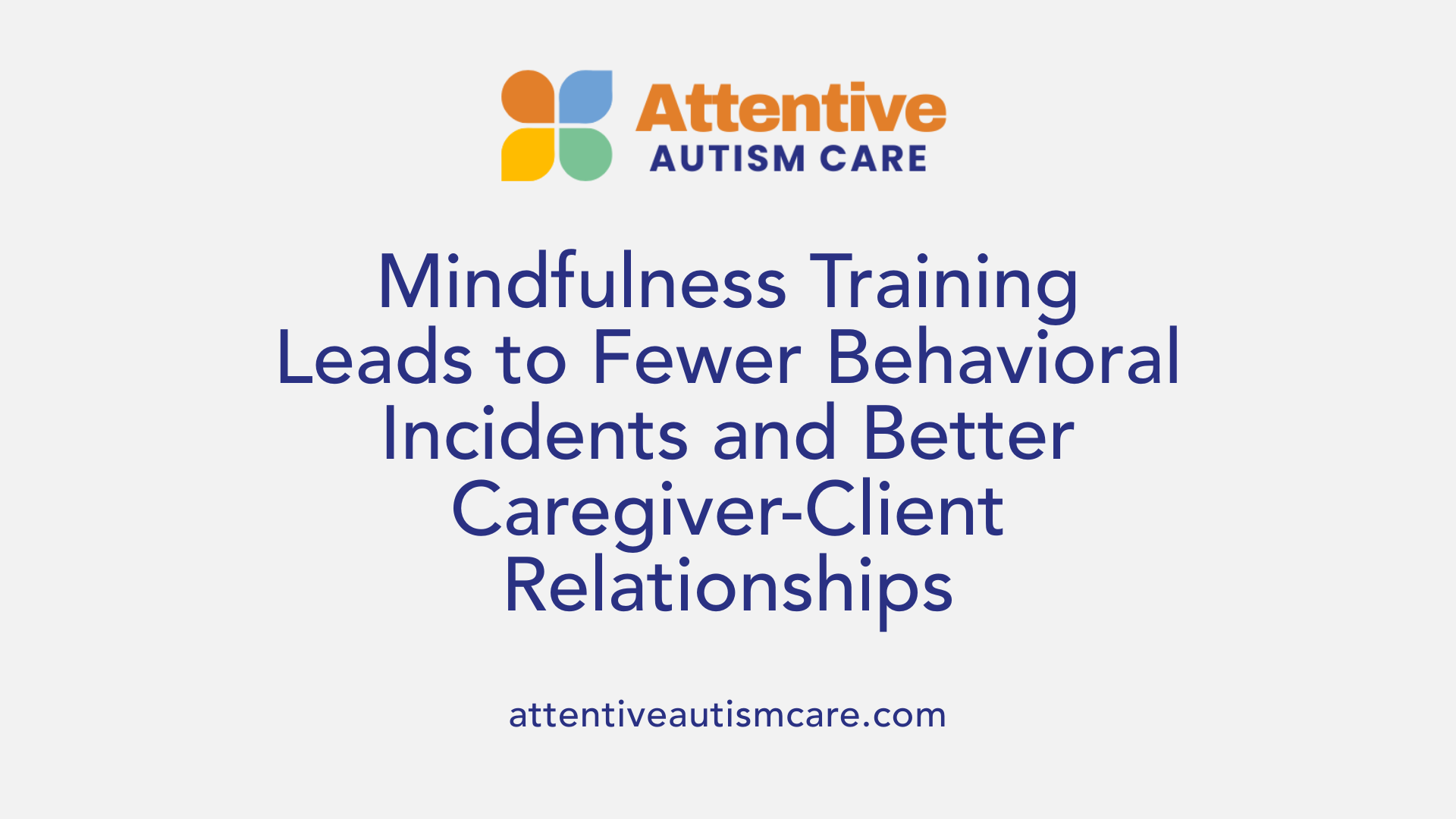
How does mindfulness training affect caregiver attendance and workplace discipline?
Mindfulness training for caregivers in autism care settings has been linked to notable improvements in workplace behavior. Caregivers who receive mindfulness-based training report fewer instances of progressive discipline and fewer call-ins, leading to reduced absenteeism. This positive effect on attendance and discipline supports a more stable and reliable workforce.
What is the influence of mindfulness on caregiver turnover and client behavioral incidents?
Lower caregiver turnover rates have been observed following mindfulness training programs, indicating increased job satisfaction and resilience. Additionally, clients under the care of mindfulness-trained professionals experience fewer behavioral episodes and display less aggression. These outcomes suggest mindfulness-enhanced caregiving improves both staff well-being and client behavior management.
How does mindfulness-based training contribute to systemic quality assurance in autism care?
Integrating mindfulness into caregiver training fosters a holistic improvement in care quality. The training correlates with reductions in physical restraint and emergency medication use among clients, reflecting safer care environments. Furthermore, such interventions produce cascading benefits by influencing both external caregiver behaviors and internal awareness. This dual effect promotes improved decision-making and emotional regulation, thereby advancing systemic quality assurance across care settings.
Overall, mindfulness-based interventions support sustainable caregiver performance and better client outcomes, creating a more effective and compassionate autism care system.
Research Evidence Supporting Mindfulness-Based Interventions for Autism

What Do Systematic Reviews and Clinical Trials Show?
Several systematic reviews and clinical trials have explored mindfulness-based interventions for children and young people (CYP) with Autism Spectrum Disorder (ASD). One comprehensive review analyzed 23 studies involving participants aged 6 to 25 years with ASD or related diagnoses. These studies examined the effects of various mindfulness techniques, delivered in clinics, homes, or schools by trained parents, educators, or clinicians.
How Do Mindfulness Interventions Improve Key Symptoms?
The evidence suggests mindfulness practices yield promising benefits in reducing anxiety, enhancing social skills, and decreasing aggressive behaviors among individuals with autism. Improvements are often measurable through assessments of emotional and behavioral functioning, with many studies reporting better stress management and social communication. Some research even indicates these gains can be maintained or grow over time following intervention completion.
What Mechanisms Underlie These Benefits?
Mindfulness enhances emotional regulation and increases tolerance of uncertainty—both critical challenges for people on the autism spectrum. By fostering self-awareness of emotions, thoughts, and bodily sensations, mindfulness supports individuals in managing sensory overloads, controlling impulsivity, and reducing social anxiety. These mechanisms facilitate calmer responses to stressful or unpredictable situations common in ASD.
What Limitations Still Exist and What Research Is Needed?
Although the current data are encouraging, many mindfulness studies have methodological limitations including small sample sizes and varying intervention protocols. More rigorous research using standardized measures and larger populations is needed to confirm and expand these findings. Ongoing studies aim to clarify optimal strategies and determine how mindfulness can best complement traditional autism therapies such as Applied Behavior Analysis (ABA).
Delivery Settings and Personnel for Mindfulness Interventions in Autism
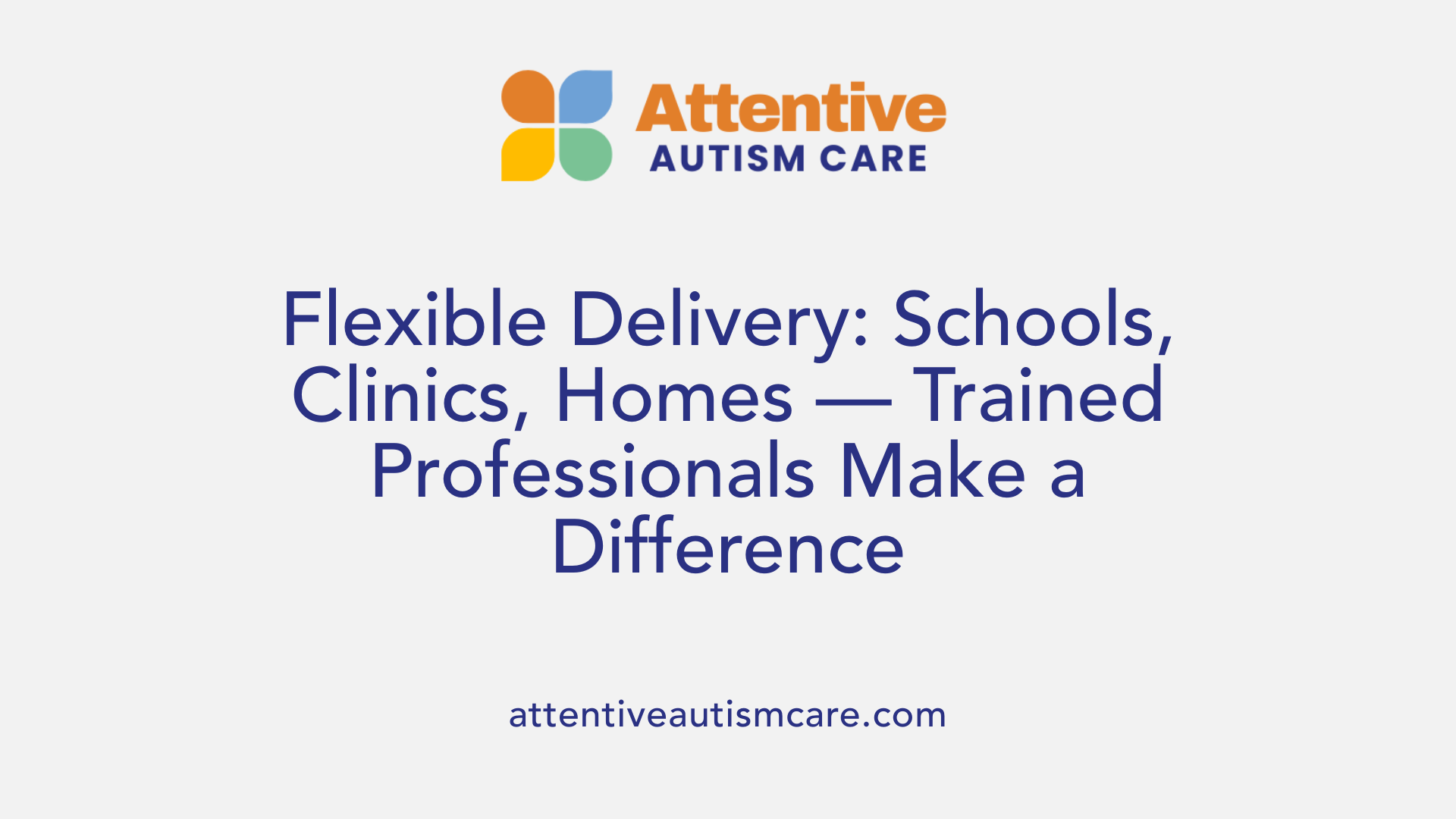
Where are mindfulness interventions for autism typically delivered?
Mindfulness programs designed for individuals with autism are versatile and can be conducted across various settings. They are commonly delivered in clinics, homes, and school environments. This flexibility ensures the interventions can be tailored to suit the comfort and routine of the person with autism, helping maximize engagement and progress.
Who commonly delivers these mindfulness interventions?
Trained parents, educators, and clinicians play significant roles in administering mindfulness practices to children and young people with autism. Parents and educators, often trained specifically for these interventions, can integrate mindfulness exercises into daily routines and learning activities. Clinicians, including therapists and special education professionals, provide structured sessions and guide the implementation of these strategies to enhance skills related to stress management, emotional regulation, and social interaction.
Are the benefits of mindfulness interventions lasting?
Follow-up studies on mindfulness interventions report that the positive effects are not only maintained over time but may even grow. Sustained benefits include improved anxiety management, enhanced social skills, and reduced aggressive behaviors. This lasting impact supports mindfulness as a valuable component in comprehensive autism support programs, encouraging more widespread adoption in various delivery settings.
Stress Triggers in Autism and Mindfulness for Managing Them

What Are Common Stress Triggers in Autism?
Individuals with Autism Spectrum Disorder (ASD) often face stress from several common but challenging situations. Unplanned time and disruptions to established routines can cause significant distress. Social situations, especially those that are difficult or unexpected, also act as major stressors. These triggers can lead to heightened anxiety and behavioral challenges, making everyday functioning more difficult.
How Does ABA Therapy Help Manage Stress in Autism?
Applied Behavior Analysis (ABA) therapy is widely used to improve communication, behavior, and social skills among individuals with autism. ABA incorporates behavioral strategies specifically aimed at stress management. Techniques like relaxation exercises, emotional regulation tactics, and structured, organized schedules help create predictability and reduce anxiety. Communication aids such as visual hints, prompting, and social storytelling support expression of needs, which decreases frustration and stress.
Can Mindfulness Reduce Acute Stress and Sensory Overload?
Mindfulness-based stress reduction (MBSR) methods have shown promising results in helping both autistic adults and parents manage stress, anxiety, and depression. Practices such as deep breathing, progressive muscle relaxation, and mindful exercises provide tools to cope with acute stress episodes and sensory overload. Incorporating these mindfulness techniques can foster greater calm and emotional regulation, ultimately enhancing mental clarity and reducing overwhelming sensations.
Together, ABA and mindfulness-based interventions offer complementary approaches to managing the unique stressors faced by individuals with autism, promoting improved well-being and quality of life.
Complementary Benefits of Combining Mindfulness with ABA Therapy
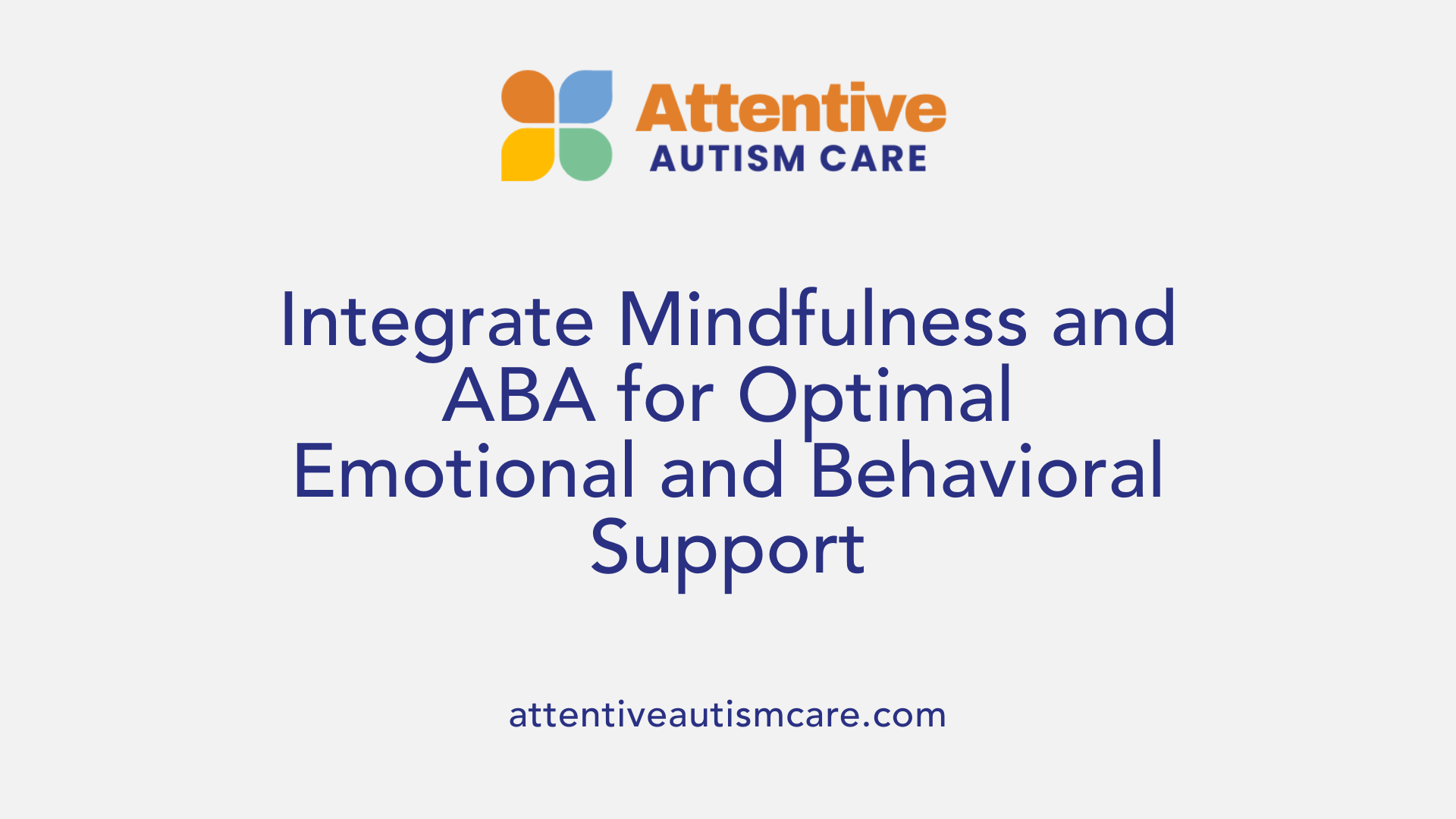
How Does Mindfulness Enhance Emotional Regulation and Self-Awareness?
Mindfulness practices improve emotional regulation by increasing awareness of emotions, thoughts, and bodily sensations. For individuals with autism, this heightened self-awareness helps manage emotional challenges and sensory overload. Mindfulness techniques like deep breathing, guided visualizations, and body scans promote serenity, reduce anxiety, and foster self-regulation, leading to better focus and mental clarity.
What Role Does ABA Play in Supporting Behavioral and Communication Skills?
Applied Behavior Analysis (ABA) therapy offers structured behavioral strategies to improve communication and reduce stress in individuals with autism. Techniques such as visual cues, prompting, social storytelling, and organized schedules help address communication challenges and enhance social skills. ABA also incorporates relaxation exercises and emotional regulation tactics, creating a predictable environment that reduces anxiety triggered by unplanned changes or disruptions.
What Are the Potential Advantages of Integrating Mindfulness with ABA?
Combining mindfulness with ABA therapy may produce cascading benefits for both individuals with autism and their caregivers. Mindfulness-based interventions improve caregiver emotional management and reduce stress, which complements ABA’s focus on behavior modification. Studies show mindfulness-trained caregivers engage more effectively, leading to fewer behavioral incidents and better client outcomes such as improved social skills and decreased aggression.
Integrating mindfulness into ABA programs fosters a balanced approach, blending the structured, evidence-based framework of ABA with mindfulness’s emphasis on present-moment awareness and emotional resilience. This integration can enhance self-regulation, reduce anxiety, and improve social communication while supporting caregiver well-being, ultimately contributing to a more supportive therapeutic environment.
Mindfulness and ABA: A Holistic Pathway to Autism Well-Being
Mindfulness techniques offer a powerful complement to Applied Behavior Analysis therapy, enhancing emotional regulation, reducing anxiety, and improving social communication for individuals with autism. When caregivers and professionals incorporate mindfulness alongside ABA’s structured behavioral strategies, the combined approach promotes better outcomes for autistic individuals and their support networks. Through continued research and tailored implementation, mindfulness has the potential to enrich autism care by supporting well-being at all levels.
References
- Mindfulness for Autism: 11 Extraordinary Benefits for Families
- Using Mindfulness to Improve Quality of Life in Caregivers ...
- The efficacy of mindfulness-based therapy for anxiety ...
- Effective Autism Stress Management Techniques
- Applied Behavior Analysis (ABA)
- Types Of ABA Therapy Jobs And Their Degree Requirements
- Applied Behavior Analysis (ABA)
- Applied Behavior Analysis (ABA)



































































































